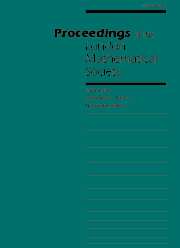Article contents
S-adic L-functions attached to the symmetric square of a newform
Published online by Cambridge University Press: 01 May 1997
Abstract
In order to apply the ideas of Iwasawa theory to the symmetric square of a newform, we need to be able to define non-archimedean analogues of its complex $L$-series. The interpolated $p$-adic $L$-function is closely connected via a “Main Conjecture” with certain Selmer groups over the cyclotomic $\Bbb Z_p$-extension of $\Bbb Q$. In the $p$-ordinary case these functions arewell understood.
In this article we extend the interpolation to an arbitrary set $S$ of good primes (not necessarily satisfying ordinarity conditions). The corresponding $S$-adic functions can be characterised in terms of certain admissibility criteria. We also allow interpolation at particular primes dividing the level of the newform.
One interesting application is to the symmetric squareof a modular elliptic curve $E$ defined over $\Bbb Q$.Our constructions yield $p$-adic $L$-functionsat all primes of stable or semi-stable reduction.If $p$ is ordinary or multiplicative the correspondinganalytic function is bounded; if $p$ is supersingularour function behaves like $\log^2(1+T)$.
1991 Mathematics Subject Classification: 11F67, 11F66, 11F33, 11F30
Information
- Type
- Research Article
- Information
- Copyright
- © London Mathematical Society 1997
- 13
- Cited by

